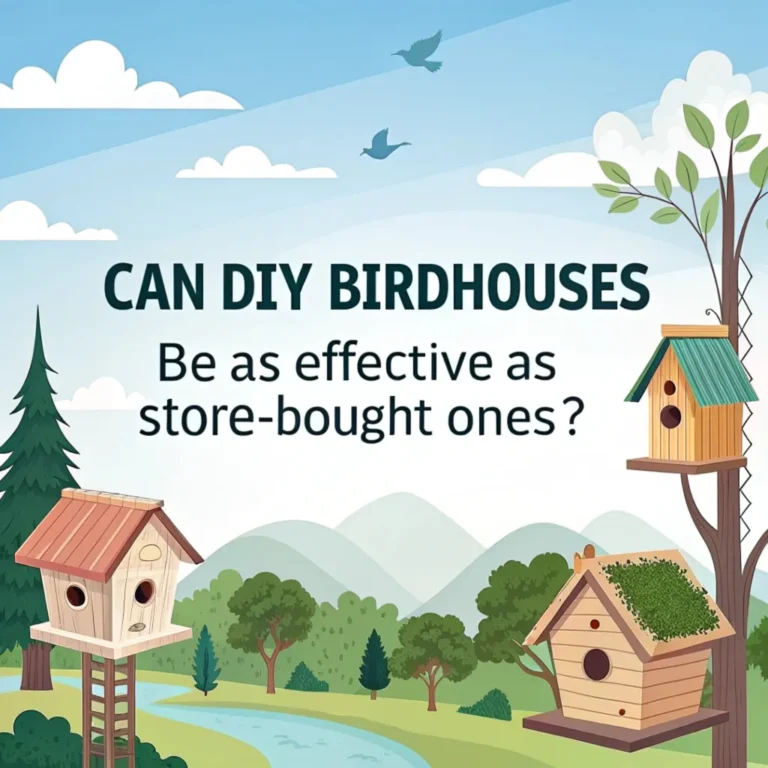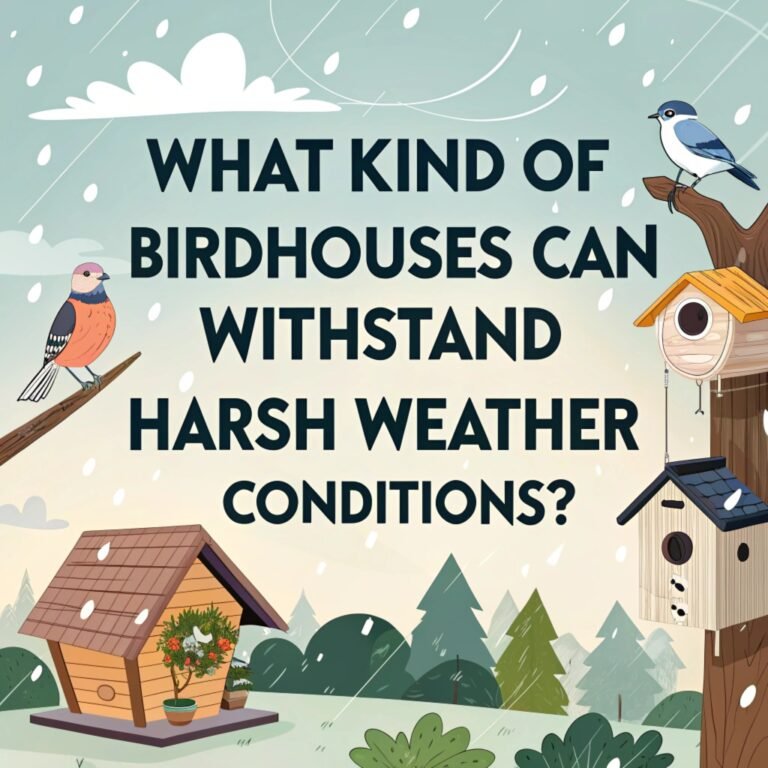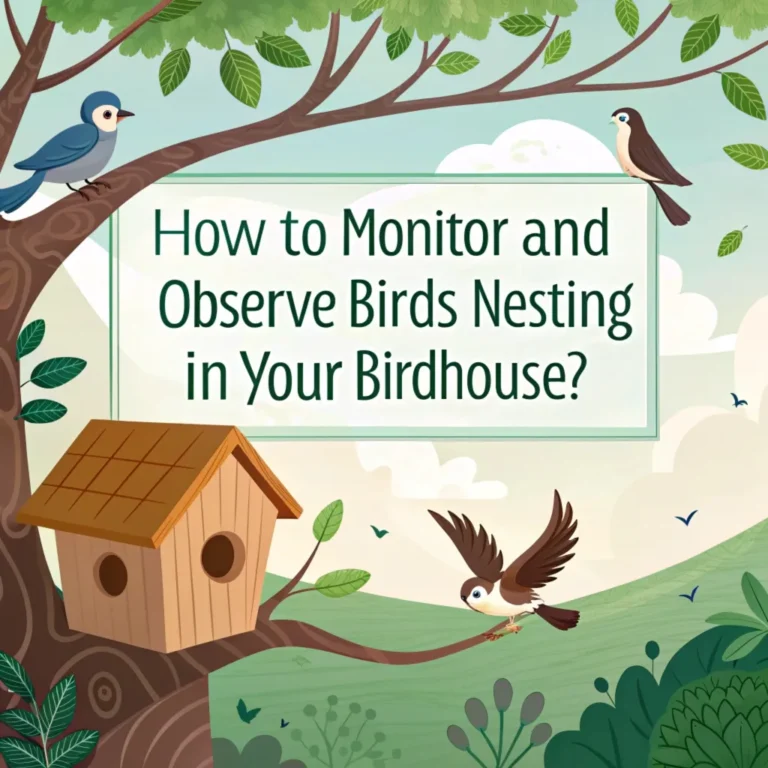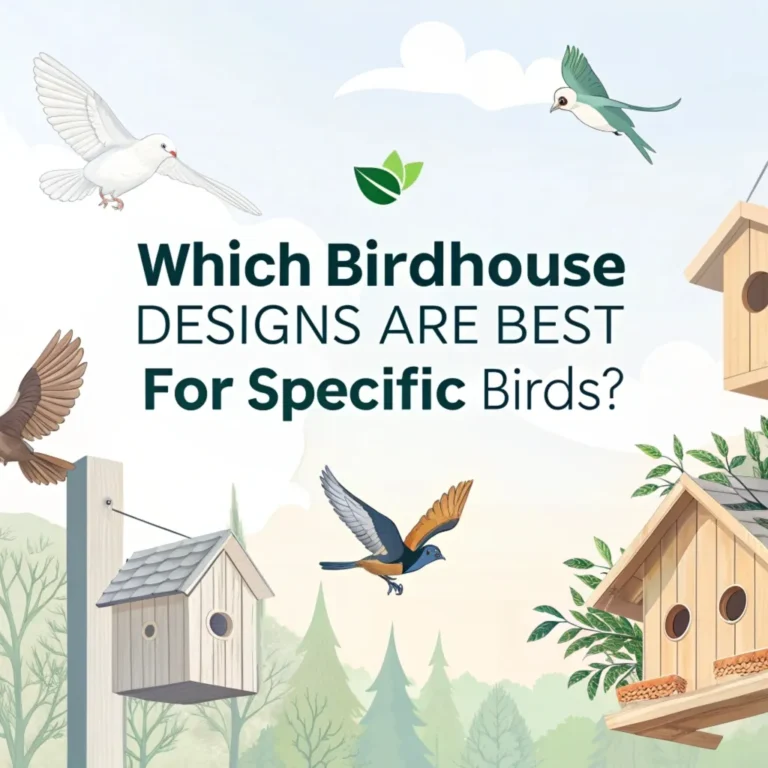How Do I Keep Larger Birds From Dominating My Feeder?
Backyard bird feeding brings joy to many. But large birds often take over feeders, leaving smaller birds hungry.
This guide offers practical solutions to create a fair feeding space for all birds. You will learn how to use special feeders, choose the right seeds, and place feeders strategically.
We also cover deterrents, alternative feeding areas, and maintenance tips. By following these strategies, you can ensure a diverse and balanced bird population in your yard.
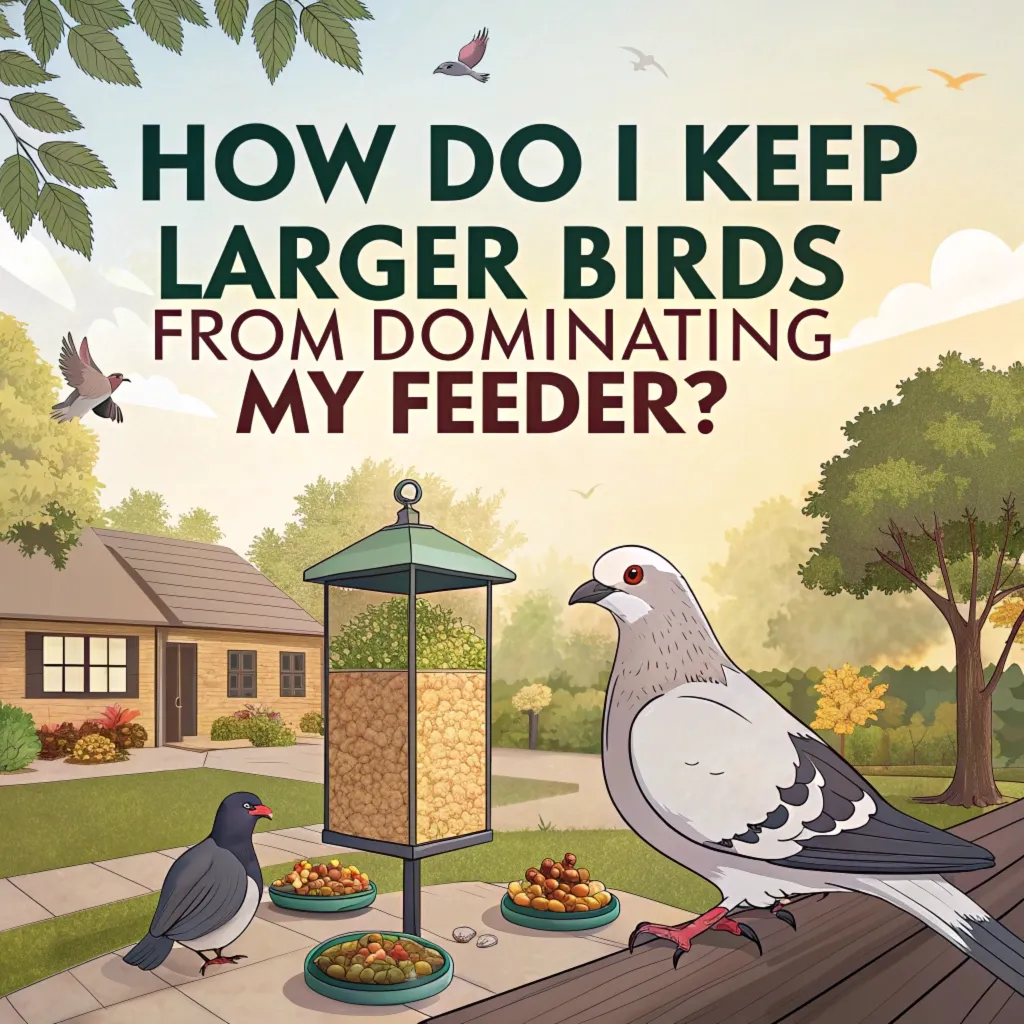
Key Takeaways
- Use specialized feeders: Select feeders designed to exclude larger birds
- Choose specific seeds: Offer seeds that larger birds dislike
- Adjust feeder placement: Position feeders to discourage larger birds
- Employ deterrents: Use physical barriers or decoys to keep larger birds away
- Provide alternative food sources: Set up separate feeding areas for different bird sizes
- Use weight-activated feeders: These close when heavier birds land
- Install baffles: Add covers to prevent larger birds from accessing food
- Offer specialized food: Use foods that appeal to smaller birds
- Implement timing strategies: Adjust feeding schedules to favor smaller birds
- Maintain cleanliness: Regular cleaning discourages pest birds
Specialized Feeder Designs
Caged feeders effectively keep larger birds away. These feeders have wire mesh surrounding the main feeding area. The mesh allows small birds to enter while blocking larger species. Caged feeders come in various styles, including tube feeders and platform feeders.
Upside-down feeders require birds to feed from below. This design suits smaller, agile birds like chickadees and finches. Larger birds find it difficult to use these feeders, reducing their access to the food.
Creating a balanced feeding environment requires understanding bird behavior. Larger birds often exhibit dominant behavior at feeders, using their size to intimidate smaller species.
This natural behavior can disrupt the feeding patterns of smaller birds, leading to an imbalanced ecosystem in your backyard. By implementing specialized feeder designs, you create safe spaces for smaller birds to feed without competition from their larger counterparts.
Seed Selection Strategies

Choosing specific seeds can deter larger birds. Safflower seeds have a bitter taste that many larger birds dislike. Smaller birds like chickadees and cardinals enjoy safflower seeds. Nyjer seeds, also known as thistle seeds, attract finches but are less appealing to larger birds.
Seed preferences vary among bird species, offering a natural way to control feeder access. Larger birds often prefer sunflower seeds and cracked corn, while smaller birds enjoy smaller seeds.
By selecting seeds that appeal to your target bird population, you can naturally discourage unwanted visitors.
This strategy not only helps manage feeder traffic but also ensures that you’re providing the most nutritious options for the birds you want to attract.
Feeder Placement Techniques
Strategic placement of feeders can discourage larger birds. Hanging feeders from thin wires or fishing lines makes it harder for heavier birds to perch.
Placing feeders near dense shrubs or trees provides cover for smaller birds, making them feel safer while feeding.
The location of your bird feeders plays a crucial role in determining which birds visit. Larger birds often prefer open spaces where they can easily spot predators and competitors.
By placing feeders in areas with more cover and obstacles, you create an environment that favors smaller, more agile birds. This approach not only helps manage feeder traffic but also promotes a more diverse bird population in your backyard.
Physical Deterrents
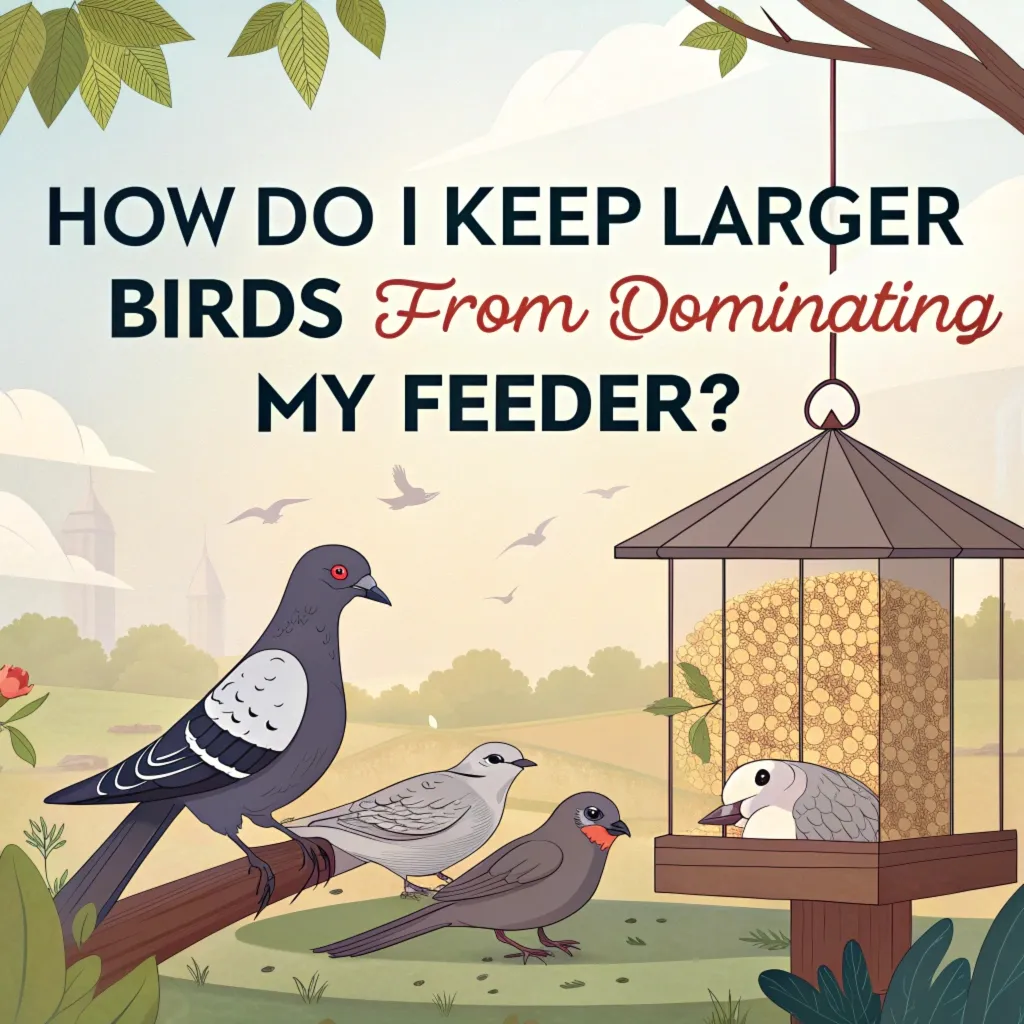
Adding physical barriers can keep larger birds away. Baffles, dome-shaped covers placed above feeders, prevent larger birds from accessing the food. Some feeders come with built-in baffles for added protection.
Decoys can also be effective. Placing a fake crow or owl near feeders may scare away larger birds. However, it’s important to move these decoys regularly to maintain their effectiveness.
Visual deterrents can be highly effective in managing bird populations at feeders. Larger birds are often more wary of potential threats, making them more likely to avoid areas with perceived danger.
Using reflective objects, such as old CDs or metallic pinwheels, can create movement and light reflections that deter larger birds. These methods are humane and cost-effective, providing a simple solution to feeder domination issues.
Alternative Feeding Areas
Creating separate feeding areas for different bird sizes can reduce competition. Set up ground feeding areas with cracked corn or millet for larger birds. This diversion keeps them away from feeders intended for smaller species.
Implementing diverse feeding zones in your yard can significantly reduce competition at feeders. By understanding the feeding preferences of different bird species, you can create tailored areas that attract specific groups.
For example, ground-feeding birds like doves and juncos prefer open areas, while tree-dwelling species like woodpeckers favor elevated feeding spots.
This approach not only manages feeder traffic but also creates a more natural feeding environment for all birds.
Weight-Activated Feeders
Weight-activated feeders close when a heavy bird lands on them. These feeders allow smaller birds to feed freely while shutting off access for larger, heavier species. Adjust the sensitivity to accommodate the desired bird sizes.
Technological solutions like weight-activated feeders offer a precise method for controlling feeder access. These feeders use a calibrated mechanism that responds to the weight of birds landing on them.
By setting the weight limit just above that of your desired small bird species, you create a selective feeding system.
This approach not only manages feeder traffic but also provides a stress-free environment for smaller birds to feed without competition.
Baffle Installation
Installing baffles above and below feeders creates barriers for larger birds. Top baffles prevent birds from landing directly on feeders.
Bottom baffles stop birds from accessing food from below. Baffles also help protect feeders from squirrels.
Baffle design plays a crucial role in their effectiveness. Dome-shaped baffles are particularly effective as they provide a smooth, slippery surface that larger birds and squirrels can’t grip. The size and placement of baffles are also important factors.
A baffle should be wide enough to prevent birds from reaching around it and positioned at a height that makes it difficult for larger birds to maneuver.
Proper installation ensures that baffles serve as an effective barrier without hindering the feeding of smaller birds.
Specialized Food Options
Offering foods that appeal to smaller birds can reduce larger bird visits. Mealworms attract bluebirds and other insect-eating species but are less interesting to larger birds. Suet feeders that only allow access from below favor smaller, more agile birds.
Dietary preferences among bird species offer a natural way to manage feeder traffic. Smaller birds often have more specialized diets, preferring foods that larger birds might ignore.
For example, nectar feeders attract hummingbirds and other small nectar-feeding species, while larger birds show little interest.
By offering a variety of food types in different feeder styles, you create a diverse feeding ecosystem that caters to a wide range of bird species without encouraging domination by larger birds.
Timing Strategies
Adjusting feeding schedules can help manage larger bird populations. Fill feeders early in the morning and late in the evening when smaller birds are more active.
Remove or cover feeders during mid-day when larger birds are more likely to visit.
Understanding bird feeding patterns allows for strategic timing of feeder availability. Many smaller birds are most active during the early morning and late afternoon hours, while larger birds may be more prevalent during midday.
By aligning your feeding schedule with the natural rhythms of your target bird population, you can create optimal feeding windows for smaller species.
This approach not only manages feeder traffic but also mimics natural feeding patterns, promoting healthier bird behaviors.
Cleanliness and Maintenance
Regular cleaning of feeders and surrounding areas discourages pest birds. Remove spilled seed from the ground to prevent attracting larger ground-feeding birds.
Clean feeders regularly to maintain hygiene and prevent the spread of diseases among birds.
Proper sanitation is crucial for maintaining a healthy bird feeding environment. Regular cleaning not only prevents the spread of diseases but also helps manage the bird population at your feeders.
Accumulated seed waste can attract unwanted species, including larger birds and rodents. By implementing a consistent cleaning routine, you create a more controlled feeding area.
This practice not only benefits the birds but also helps maintain a tidy and attractive backyard space.
FAQs
How often should I clean my bird feeders?
Clean bird feeders at least once every two weeks. Clean more frequently during wet weather or if you notice sick birds in your yard.
Can I use hot pepper to deter larger birds?
Adding hot pepper to bird seed can deter mammals like squirrels but doesn’t affect birds. It’s not an effective method for deterring larger birds.
Are there any plants I can grow to attract smaller birds?
Native plants that produce berries or seeds, such as sunflowers, coneflowers, and berry bushes, attract a variety of smaller birds to your yard.
How can I prevent squirrels from dominating my bird feeders?
Use squirrel-proof feeders, place feeders away from jumping points, and add baffles to feeder poles to prevent squirrels from accessing the food.
Is it harmful to birds if I stop feeding them suddenly?
Birds don’t become dependent on feeders. They use them as a supplementary food source. You can stop feeding at any time without harming the birds.
What’s the best way to attract a variety of bird species?
Offer a diverse range of foods, including seeds, fruits, and suet. Provide water sources and create a habitat with native plants to attract different bird species.

Luna is the passionate founder and author of Birds and You, a website dedicated to sharing her love for birds with fellow enthusiasts. Through her engaging articles and guides, she aims to educate and inspire others to explore the fascinating world of birds. When she’s not writing, you can find Luna observing birds in their natural habitats or sharing beautiful bird photography on Pinterest. Join her on this journey to celebrate and protect our feathered friends!


